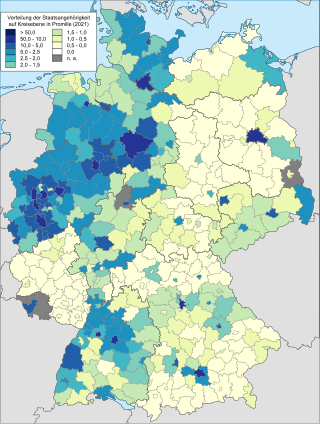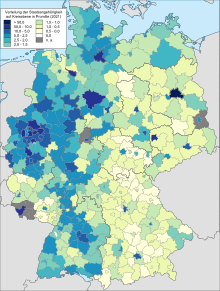
Immigration to Germany, both in the country's modern borders and the many political entities that preceded it, has occurred throughout the country's history. Today, Germany is one of the most popular destinations for immigrants in the world, with well over 1 million people moving there each year since 2013. As of 2019, around 13.7 million people living in Germany, or about 17% of the population, are first-generation immigrants.

Tell Abyad is a town in northern Syria. It is the administrative center of the Tell Abyad District within the Raqqa Governorate. Located along the Balikh River, it constitutes a divided city with the bordering city of Akçakale in Turkey.
Syrian Turkmen are Syrian citizens of Turkish origin who mainly trace their roots to Anatolia. Turkish-speaking Syrian Turkmen make up the third largest ethnic group in the country, after the Arabs and Kurds respectively.

Syrian diaspora refers to Syrian people and their descendants who chose or were forced to emigrate from Syria and now reside in other countries as immigrants, or as refugees of the Syrian Civil War.

The Greeks in Germany comprise German residents or citizens of Greek heritage and Greeks who immigrated to Germany. According to the Federal Statistical Office of Germany, 453,000 people living in Germany in 2019 had full or partial Greek ancestry. 363,650 of these were Greek citizens.
German Afghans are German citizens with Afghan ancestry and non-citizen residents born in, or with ancestors from, Afghanistan. It is the largest Afghan community in Europe and part of the worldwide Afghan diaspora, of which it is one of the largest. In 2022, the Federal Statistical Office of Germany estimated the number of people of Afghan descent residing in Germany at 425,000 the third largest from outside the EU, and the largest group from Asia excluding the Middle East and Caucusus. In particular, there are over 50,000 Afghans in Hamburg alone, comprising over 7% of the city's population. Offenbach am Main and Hamburg had the highest shares of Afghan migrants among all German districts in 2011. There were 51,000 people of Afghan decent living in Hamburg in 2023.
The Albanians in Germany refers to the Albanian migrants in Germany and their descendants. They mostly trace their origins to Albania, Kosovo and to a lesser extent to North Macedonia and other Albanian-speaking territories in the Balkan Peninsula. Their exact number is difficult to determine as some ethnic Albanians hold German, Macedonian, Serbian or another Former Yugoslavian citizenship.

In the narrow sense, Lebanese people in Germany include migrants from Lebanon living in Germany and their descendants, excluding Palestinians.

Iraqis in Germany include migrants from Iraq to Germany, as well as their descendants. The number of Iraqis and Iraqi-Germans in Germany is estimated at around 310,000 people. The Iraqi community is ethnically, culturally and linguistically diverse and includes Mesopotamian Arabs, Kurds, Iraqi Turkmen, Mandaeans, Assyrians and Yezidis.
Syrians in Austria include migrants from Syria to Austria, as well as their descendants. The number of Syrians in Austria is estimated at around 18,000 people in December 2015, and it consists mainly of refugees of the Syrian Civil War.

Abdurrahman Mustafa is a Syrian Turkmen politician who is the incumbent president of the Syrian Turkmen Assembly, the umbrella organization of the Turkmen political movements in Syria, and the political leader of the Turkmen national movement of Syria. On 6 May 2018, he was elected as the head of the Syrian National Coalition.
Al-Rai, is a small town in northern Aleppo Governorate, northern Syria. With 4,609 inhabitants, as per the 2004 census, al-Rai is the administrative center of the sparsely populated Nahiya al-Rai. Located on the Istanbul-Baghdad Railway and close to the Turkish border, right across Elbeyli, it is however a strategically important village. The town of Akhtarin, some 15 kilometers (9.3 mi) to the southwest. Larger towns are Azaz, some 35 kilometers (22 mi) to the west, and Jarablus and Manbij, both some 45 kilometers (28 mi) to the east.
Al-Fursan is a village in northern Aleppo Governorate, northwestern Syria. Administratively belonging to Nahiya Ghandoura in Jarabulus District, the village is inhabited by Turkmen and had a population of 565 as per the 2004 census. It is located midway between Al-Rai and Jarabulus, at the eastern banks of Sajur Lake. Nearby localities include Arab Azzah to the north and Lilawa to the southeast.
Arab Azzah is a village in northern Aleppo Governorate, northwestern Syria. It is located midway between al-Rai and Jarabulus, at the eastern banks of Sajur River, just north of Sajur Lake and close to the Syria–Turkey border. Administratively belonging to Nahiya Ghandoura in Jarabulus District, the village has a population of 417 as per the 2004 census. The village is inhabited by Turkmen of the Elbegli tribe.
al-Yaarubiyah, also known as Daliha, is a village in northern Aleppo Governorate, northwestern Syria. Located halfway between Azaz and al-Rai, approximately 45 kilometres (28 mi) north of the city of Aleppo and 3 km (1.9 mi) south of the border to the Turkish province of Kilis, the village administratively belongs to Nahiya Sawran in Azaz District. Nearby localities include Baraghida 3 km (1.9 mi) to the southwest and Dudiyan 5 km (3.1 mi) to the southeast.
Al-Judaydah, formerly Yeniyapan, is a village in northern Aleppo Governorate, northwestern Syria. Located halfway between Azaz and al-Rai, some 45 kilometres (28 mi) north of the city of Aleppo and 5 km (3.1 mi) south of the border to the Turkish province of Kilis, the village administratively belongs to Nahiya Sawran in Azaz District. Nearby localities include Dudiyan 3 km (1.9 mi) to the northeast and Murayghil 2 km (1.2 mi) to the south.
Hawar Kilis, alternatively spelled Hiwar Kalas, is a village in northern Aleppo Governorate, northwestern Syria. It is located between Azaz and Al-Rai, on the Queiq Plain, some 45 kilometres (28 mi) north of the city of Aleppo, and just 2 km (1.2 mi) south of the border with the Turkish province of Kilis.
Kadrish is a village in northern Aleppo Governorate, northwestern Syria. It is located on the Queiq Plain, between Sawran and al-Rai, about 40 kilometres (25 mi) northeast of the city of Aleppo, and 8 km (5.0 mi) south of the border to the Turkish province of Kilis. The village is inhabited by Turkmen. Traveler Martin Hartmann noted the village as a Turkmen settlement in late 19th century.
Jalamah, also spelled as Djélémé or Jalmé is a town in northern Syria situated in Afrin District. It is located on the southern edge of the Afrin plain, 60 kilometres (37 mi) northwest by road from Aleppo and 19 kilometres (12 mi) southwest of Afrin. Nearby localities include Jindires to the northwest, Askê to the east and Afrin to the northeast. The village is inhabited by Turkmen. On March 11, 2018, the town came under the control of the Syrian National Army.

Sarah Mardini, alternative spelling Sara Mardini, is a Syrian former competition swimmer, lifeguard and human rights activist. Fleeing her country in 2015 during the Syrian civil war with her sister, Olympic swimmer Yusra Mardini, they pulled their boat with other refugees towards the Mediterranean coast of Greece, saving themselves and the other passengers. Continuing their journey across the Balkans, they reached Berlin, Germany, the same year. She was named one of the 100 most influential people in the world by Time magazine in 2023, alongside her sister.









